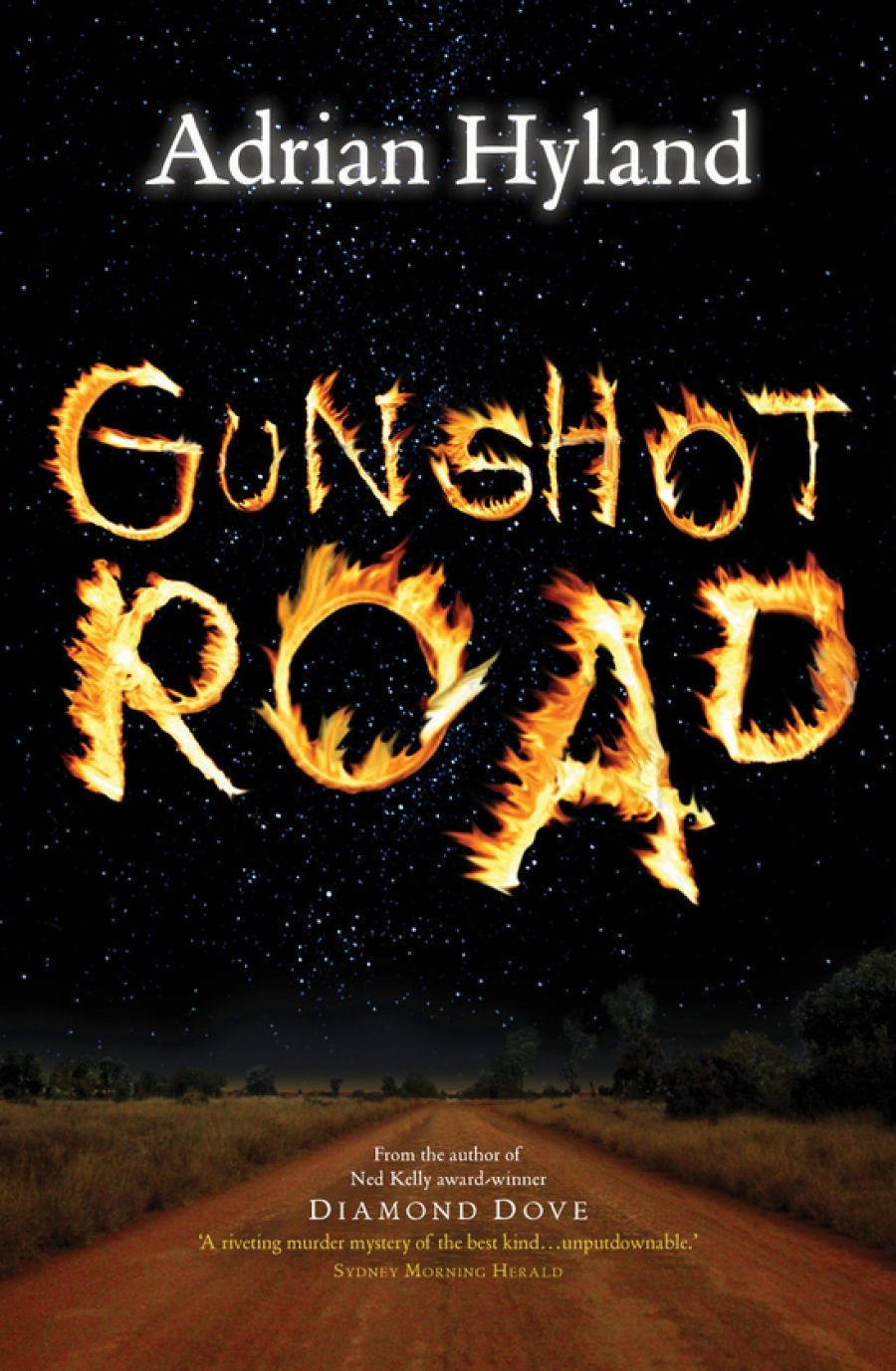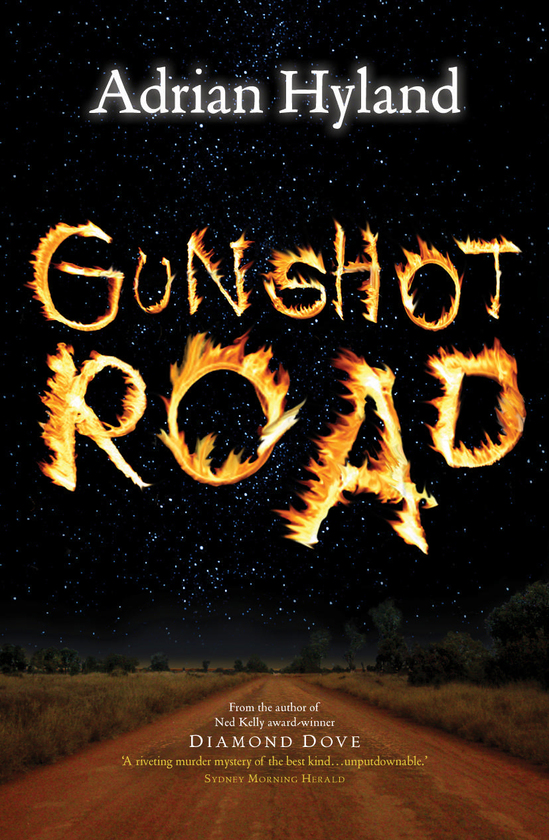
- Free Article: No
- Contents Category: Fiction
- Review Article: Yes
- Article Title: Entrapment
- Online Only: No
- Custom Highlight Text:
Two drunk whitefellas have a barney at the Green Swamp Well Roadhouse. One ends up with a hammer in his throat. To the police, it is a simple case of provocation and retaliatory murder, but the newly appointed Aboriginal Community Police Officer (ACPO) for Bluebush in the Northern Territory thinks otherwise. As a local, Emily Tempest knows the feuding boozers and doubts that an argument – over Greek philosophy, of all things – might have incited such mortal violence. Tempest vividly returns in Gunshot Road, Adrian Hyland’s sequel to Diamond Dove (2006). Once again, the amateur sleuth returns home to Moonlight Downs and is drawn into a web of increasing stickiness. Her reckless bravura results in her own entrapment.
- Book 1 Title: Gunshot Road
- Book 1 Biblio: Text Publishing, $32.95 pb, 388 pp
- Book 1 Cover Small (400 x 600):

Like all good sequels, Gunshot Road is a discrete entity and functions perfectly well on its own. Those familiar with Hyland’s début will be pleased to meet Tempest again and to be apprised of her latest activities. Those yet to make her acquaintance are given enough information with which to patch together her history. With a white father and Aboriginal mother, Emily, whose position is intermediary and placatory, seems an ideal liaison officer between both racial camps. However, the police’s perfunctory treatment of the homicide case so enrages our maverick agent that she decides to conduct her own investigation, to the irritation of her boss, Acting Superintendent Bruce Cockburn. If Emily’s surname conjures up a whirlwind of tumultuous (and unwelcome) activity, Cockburn is altogether too cocksure for his own good.
The friction between them continues in the time-honoured tradition of simmering tension or outright hostility between the outsider and the Establishment. But there is more to it than just mutual distrust. Tempest’s ambivalence at being a mere subaltern stems from her distrust of the authorities. Of the Bluebush cop shop she says, ‘to me and my mob it was the locus of all fear, the dark tower in the medieval legend, the place where little children – and grown men – went in and never came out’. But, being a ‘Clayton’s’ cop, Emily can afford to bend the rules in her quest to find the killer of Albert Ozolins, better known as ‘Doc’. The knockabout geologist, before his death, was in the middle of researching a theory called the Snowball Earth, which posits that 600 million years ago the earth was covered in ice and that the first complex life forms evolved from the subsequent thaw. His fossicking seems to have interested parties with their own agendas about the land, and Emily’s own innate knowledge leads her to intuit that something is amiss. Like Hyland’s previous book, this whodunit also canvasses the uneasy nexus between the spiritual and the material, development and environment. The cleaving of Dreamtime stories, myth and song to the forces of industrial and mining enterprise is seamlessly wrought.
Confidently written in the first person, Gunshot Road is carried along by a feisty, motor-mouth heroine, but a middle-aged white man writing in the guise of a young, black woman raises questions of credibility and fidelity: are Hyland’s ventriloquist abilities skilful enough to suspend disbelief? Fortunately, the act is convincing. The author has worked for years within indigenous communities in the Red Centre; his experience permeates the book and informs the narrative. Race relations, geopolitics and Aboriginal spirituality are interwoven throughout Gunshot Road, in short, punchy chapters.
Despite these worthy themes, there is nothing heavy-handed or earnest about the novel. What is so refreshing about it is the irreverent humour. Hyland has a lovely way with the vernacular. You know you’re in for a treat when early on he writes about an unreliable rooster whose crow has remained out of sync ever since it discovered someone’s dope. Whether it is the unruffled Cockburn with his ‘internal air-conditioning’, or another cop who ‘wore his belly like a weapon’, Hyland’s language is like a welcoming breeze in the stultifying heat of the Territory.
It is just as well that the diminutive Tempest is such a spitfire, given the numbers of unreconstructed males she has to contend with in this panorama of drunkards, bruisers, miners and rednecks. Politically correct language isn’t practised in these parts. Jet, a spiky Tibetan artist whose canny drawings of Doc’s rock formations set Tempest on the right track, is summarily named a ‘chinger’, and Tempest herself is referred to as ‘the little black bint’ and a ‘jumped up little gin’. Hyland does not whitewash or romanticise the living conditions in the bush, where drought is perennial, idleness and delinquency are rife, and the threat of violence is but a stone’s throw away. But he has great affection for the rough-hewn dwellers scratching at the fringes of civilisation, and his secondary characters are also deftly drawn, including Jet, Jojo (Emily’s charming park ranger boyfriend), and Danny, an Aboriginal adolescent who is possessed by demons beyond those fuelled by alcohol and drugs.
Thanks to the likes of Peter Temple and Shane Maloney, Australia has a thriving crime fiction scene. This new kid on the block has plenty to recommend it; it hurries along at a cracking pace, has pails of red herrings and likely suspects, and features a modern, sassy heroine. Move over Murray Whelan and make some room for Emily Tempest.


Comments powered by CComment